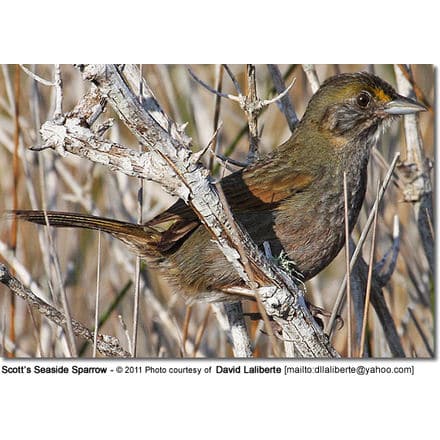Hummingbirds found in Nevada, USA
Hummingbirds found in Nevada, USA (by U.S. State) … Canada … Mexico … Puerto Rico … Jamaica … Honduras
Hummingbird Information … Hummingbird Species Photo Gallery
The following hummingbird species are known to occur in Nevada.
Most hummingbirds visiting Nevada are seasonal visitors that arrive in mid-March for the summer season and leave by mid-September for their wintering territories. The exceptions are Costa’s and Anna’s Hummingbirds, which may remain year-round.
Anna’s Hummingbirds, Calypte anna – Native- The only year-round residents and the largest hummingbird species in that region. They nests from December to June in the foothills of Nevada.
One of the larger and the most vocal hummingbirds in the United States, where it is the only species to produce a song; specifically the males produce a complex series of scratchy noises, sounding like a sharp “chee-chee-chee; when moving from flower to flower, they emit toneless “chip” vocalizations. All other hummingbirds in the United States are mostly silent.
They are well known for their territorial behavior; the male makes elaborate dive displays at other birds and sometimes even at people. At the bottom of their dives, they produce high-pitched loud popping sounds with their tail feathers.
Males have glossy dark rose-red throats and crowns, which may appear black or dark purple in low light. The underside is mostly greyish; and the back metallic green.
Females have light grey chests with white and red spotting on the throat, greenish back and white tipped tails.
They resemble the Costa’s Hummingbirds, but the male’s Costa’s Hummingbird‘s gorget (throat feathers) is longer than that of the Anna’s. They are larger than the Rufous Hummingbirds and lack the rusty coloration of the Rufous Hummingbirds.
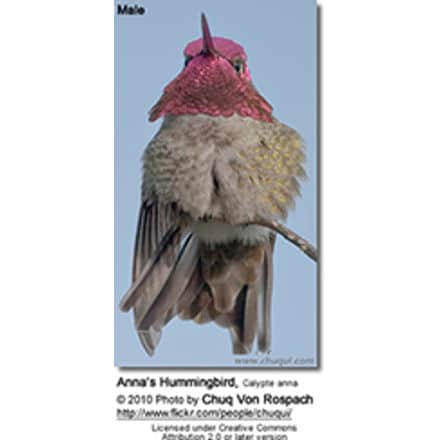
Black-chinned Hummingbirds, Archilochus alexandri – Native. They nest from April to August in lowland areas; and may move up into foothills or lower elevations of mountain slopes later in the season.
The smallest hummingbird in that region.
The male has a black, shimmering throat with a purple edge and pale feathers below that create a collar. However, unless the light is just right, the head looks all black. His back is green and there are some green feathers covering the chest.
The female is pale below (sometimes with a slightly speckled throat) and her back is green.
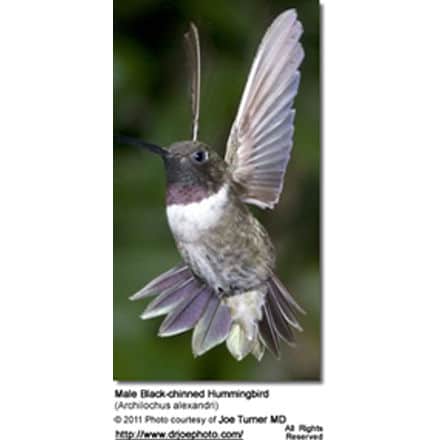
Costa’s Hummingbirds, Calypte costae – Native- Historically only summer visitors; however, an increasing number of them now remain year-round residents – Fairly common in southern Nevada, around Boulder Beach at Lake Mead and in gardens around Boulder City.
Males can easily be identified by the glossy purple crown and long, conspicuous throat feathers that project markedly down the side of the throats, giving it an elongated “moustache” appearance. The back is metallic green.
Females have greyish-green crowns (fop of the head) and backs. The chin and the plumage below are whitish, except for some black spotting on her throat. Her flanks are buffy-colored. She has a dark tail with white tips on the outer tail feathers.
They resemble the Anna’s Hummingbirds, but the male’s gorget (throat feathers) is longer than that of the Anna’s.
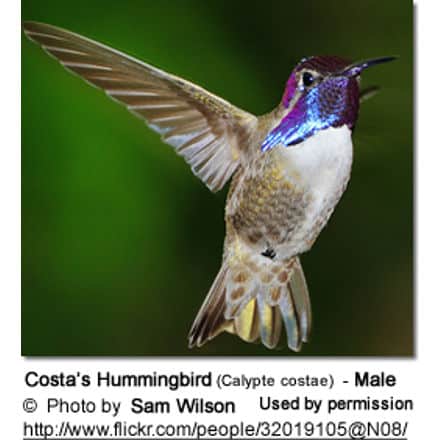
Broad-tailed Hummingbirds, Selasphorus platycercus – Native- Seasonal Migrant. Move south to winter in Mexico, Guatemala and, occasionally, El Salvador.
Males can most easily be identified by their iridescent, rose-red throats, white chest feathers and metallic green back and crown and their rounded tails. The males’ tails make whistling noises in flight.
Females lack the flashy throat patch of the male and are mostly pale below. Their white-tipped outer tail feathers are rust-colored close to the body and blackish in the center; the tail feathers in the center range from green to blackish.
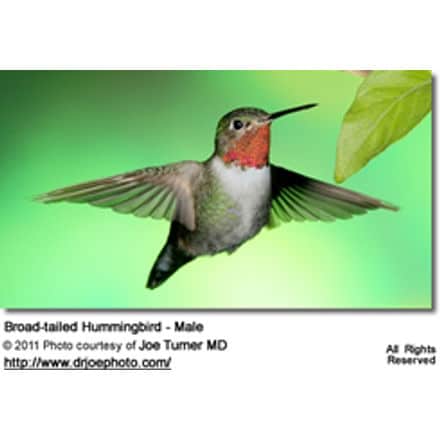
Calliope Hummingbirds, Stellula calliope – Native- Seasonal Migrant – They nest from mid-May through July in high mountain forests and meadows, almost to timberline. They migrate south or east for the winter.
The smallest breeding bird in North America. They are most easily confused with the Rufous Hummingbirds and the Broad-tailed Hummingbird.
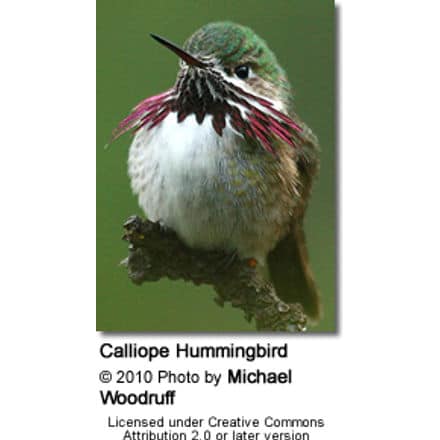
Rufous Hummingbird, Selasphorus rufus –Seasonal Migrants – Occur in Nevada from March through May – during the northward migration to their breeding grounds in the Pacific Northwest to Alaska; and again as they travel south to their wintering territories in Mexico and Central America in late June through September.
These hummingbirds are usually found in gardens and at feeders. These birds are fearless, and are known for chasing away other hummingbirds and even larger birds, or rodents away from their favorite nectar feeders and flowers.
Males can easily be identified by their glossy orange-red throats.
Females have whitish, speckled throats, green backs and crowns, and rufous, white-tipped tail feathers.
Allen’s Hummingbirds, Selasphorus sasin – Rare vagrants – The Allen’s Hummingbird is often confused with the Rufous Hummingbird, but the Allen’s can be identified by the green back whereas the Rufous Hummingbird has a coppery back.
The male has a throat that ranges in color from orange-red to yellow-orange, a back that is bright green, a rump that is rufous and its tail feathers are rufous tipped in black.
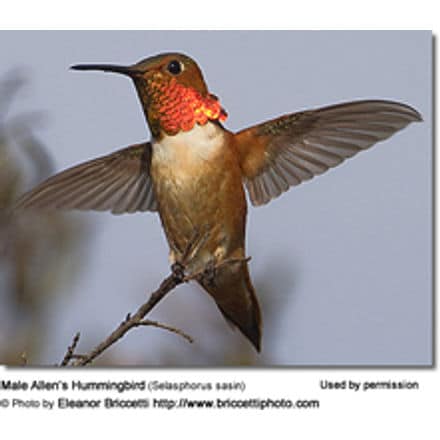
Broad-billed Hummingbirds (Cynanthus latirostris ssp magicus) – Rare vagrants – These mostly Mexican hummingbirds venture into the United States regularly; they mostly visit the southern parts – but a few vagrants travel as far north as Wisconsin.
The male is glossy green above and on the chest. He has a deep blue throat. His straight and slender beak is red with a black tip. His slightly forked tail is dark above, and the under tail feathers are white.
The female is less colorful than the male. Her throat, chest and belly are light to medium grey. She has a white stripe over each eye.
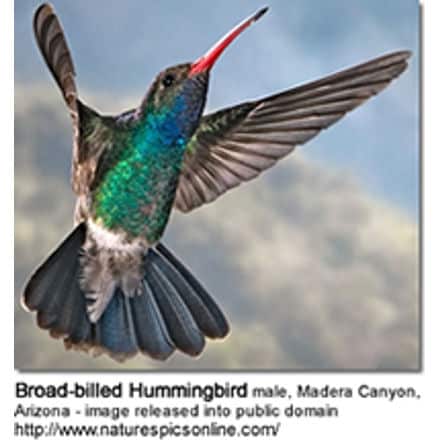
Magnificent or Refulgent Hummingbirds (Eugenes fulgens) – Rare visitors
These are large hummingbirds and can often be identified by their size alone.
The male has a metallic green throat and a black chest. His forehead and crown are purple and the back is dark green.
The female plumage is less bright. Her chest is solid grey. Her back and crown are olive green. Her tail feathers are pearl-grey tipped.

